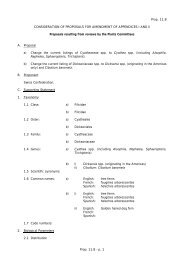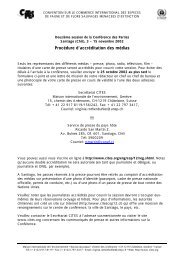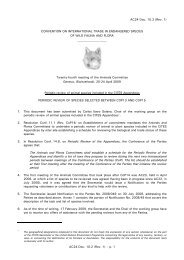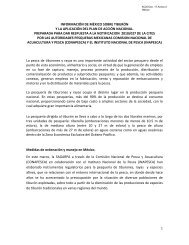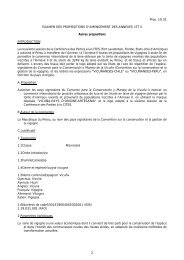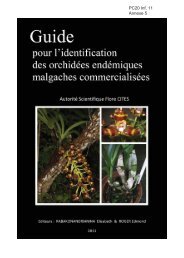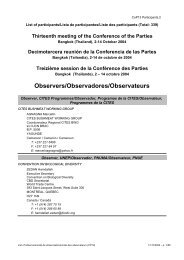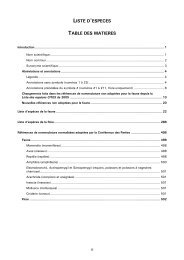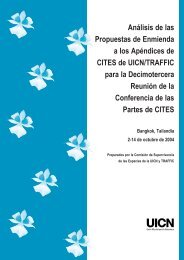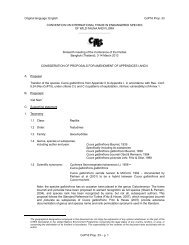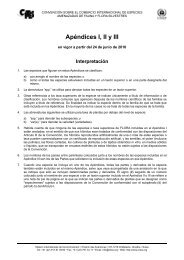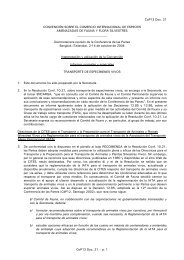Lamna nasus - Cites
Lamna nasus - Cites
Lamna nasus - Cites
Create successful ePaper yourself
Turn your PDF publications into a flip-book with our unique Google optimized e-Paper software.
Draft Proposal to list <strong>Lamna</strong> <strong>nasus</strong> in Appendix II - prepared by Germany in January 2012<br />
2001a, 2001b) and reduced again in 2006. Landings have since ranged from 139t to 229t. Total population<br />
numbers have remained relatively stable since 2002, although female spawners may have continued to decline<br />
slightly. ICCAT SCRS/ICES (2009) estimated that spawning stock biomass (SSB) is now about 95–103% of<br />
its size in 2001 and the number of mature females 83% to 103% of the 2001 value (Figure 13), or 12–16% of<br />
baseline.<br />
Stock assessments have determined that recovery is possible, but Campana et al. (2010b) warn that the<br />
trajectory is extremely low and sensitive to human-induced mortality. Human-induced mortality of ~2 to 4%<br />
of the vulnerable biomass of 4,500t to 4,800t (equivalent to catching 185–192t in 2005) should allow recovery<br />
to 20% of virgin biomass (SSN20%) in 10–30 years. Recovery to maximum sustainable yield (SSNmsy) will take<br />
much longer: between 2030 and 2060 with no human-induced mortality, or into the 22nd century (or later)<br />
with an incidental harm rate of 4%. At an incidental harm rate of 7% of the vulnerable biomass, corresponding<br />
to a catch of 315t, the population will not recover to SSNmsy (Figures 14 and 15). Campana and Gibson (2008)<br />
also warned that a high seas fishery exploiting this stock jeopardizes Canada’s fisheries management and<br />
recovery plan – the population would crash at these exploitation rates.<br />
In addition to the Canadian quota of 185t, in 1999 a quota of 92t was set in the US EEZ, which is presumed to<br />
share the same stock. The TAC for all US fisheries was reduced to 11t, including a commercial quota of 1.7t,<br />
in 2008. Taiwanese, Korean and Japanese tuna longliners take a largely unknown bycatch of L. <strong>nasus</strong> on the<br />
high seas in the North Atlantic (ICES 2005). Most of the catch is reportedly discarded or landed at ports near<br />
the fishing grounds. Stocks and catches are “under investigation” (Fishery Agency of Japan 2004). Campana<br />
and Gibson (2008) note that the unreported porbeagle bycatch observed on Japanese vessels could have<br />
amounted to ~200t in 2000 and 2001. These levels of combined Northwest Atlantic landings may prevent<br />
stock recovery.<br />
4.4.2 Southern Hemisphere<br />
Observer data from the Uruguayan tuna and swordfish fleet were used to assess the status of the Southwest<br />
Atlantic stock. The assessment identified an 82% decline in biomass (SSB) since 1961, and 60% since 1982,<br />
to well below maximum sustainable level (BMSY) (Figure 19, ICCAT SCRS/ICES 2009), mirroring the decline<br />
in CPUE (Figure 18). This stock probably extends into the Southeast Pacific. Data were not available to<br />
support an assessment of the Southeast Atlantic/Southwest Indian Ocean stock.<br />
FAO FISHSTAT data have been greatly improved in recent years; southern hemisphere catch data are now<br />
available for several countries since the mid 1990s (Figure 20); these show a declining trend, with New<br />
Zealand catches dominating, followed by Spain (which now has a zero quota for porbeagle in EU and<br />
international waters) and Uruguay (FAO FISHSTAT). New Zealand commercial catch, discard and<br />
processing records are illustrated in Figure 16. Volumes processed are sometimes higher than reported<br />
catches. Estimates of tuna longline bycatch are not available for all years and are imprecise because of low<br />
observer coverage. Approximately 60% of longline bycatch is alive when retrieved. Survival of unprocessed<br />
discarded sharks is unknown. About 80% of the bycatch is processed, 80% of this is finned, 20% processed<br />
for the meat and fins (MFSC 2008). There has been a 75% decline in the total weight of L. <strong>nasus</strong> reported<br />
since 1998–99, to a low of 55 t in 2005-06. This decline began during a period of rapidly increasing domestic<br />
fishing effort in the tuna longline fishery, and has accelerated since tuna longline effort dropped during the<br />
last two years. Unstandardised catch per unit effort recorded by observers from 1992–93 to 2004–05 varies<br />
considerably, but has been extremely low in recent years (Figure 17). This may not reflect stock abundance<br />
because of low observer coverage and other potential sources of variation (e.g., vessel, gear, location and<br />
season). [An updated assessment is in preparation and will be incorporated later when available. ]<br />
Japanese tuna longline vessels take an unknown quantity of bycatch of L. <strong>nasus</strong> in the Southern Bluefin Tuna<br />
fishing grounds. Standardised CPUE has varied from 1992 to 2002 but recent stock trends were deemed to be<br />
stable. Current stock levels are under investigation. Most of the catch is reportedly discarded or landed at<br />
ports near the fishing grounds (Fishery Agency of Japan 2004), but do not appear in the FAO FISHSTAT<br />
database. Matsumoto (2005, cited in FAO 2007) reports an increase from very low levels during 1989–1995<br />
followed by a decline in annual landings to around 40% of original levels between 1997 and 2003. Matsunaga<br />
(2009) reported no porbeagle bycatch trend in the same fishery from 1992 to 2007.<br />
4.5 Geographic trends<br />
This species now appears to be scarce, if not absent, in areas of the Mediterranean where it was formerly<br />
commonly reported (Ferretti et al. 2008, Stevens et al. 2006).<br />
Page 7 of 14<br />
AC26 Doc. 26.2, Annex 1 – p. 7<br />
AC26 Doc. 26.2<br />
Annex / Anexo /Annexe<br />
(English only / únicamente en inglés / seulement en anglais)




